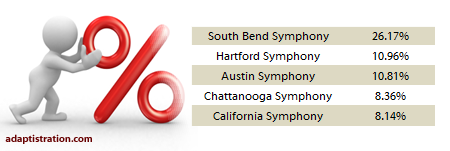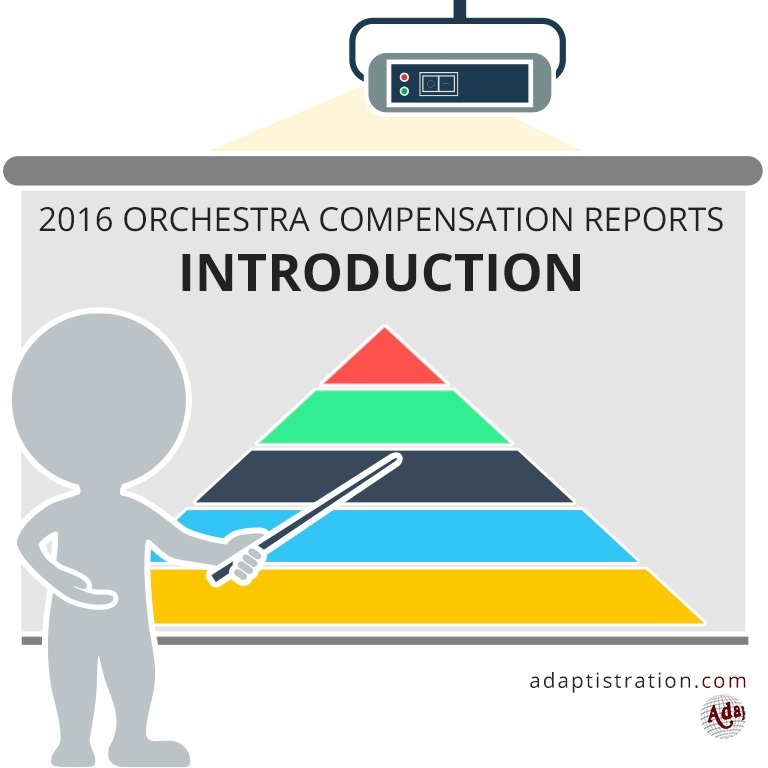Even though the 2006/07 season provided the average Regional Orchestra Players Association (ROPA) music director with reasonable improvements in compensation, there is no doubt that this group of stakeholders is well compensated for expected levels of commitment as compared to executive and musician stakeholders…
WHERE THE DATA COMES FROM
In order to provide information that is as accurate as possible, data from the 2006/07 season is gathered from the following sources:
- Music director compensation figures were obtained from their respective orchestra’s IRS Form 990 for the 2006/07 concert season.
- Total Expenditures were also obtained from each respective orchestra’s IRS Form 990 for the2006/07 concert season.
- Base Musician compensation figures were obtained from records collected by the American Federation of Musicians (AFM) for the 2006/07 concert season.
Adaptistration makes no claim to the accuracy of information from documents compiled or reported by external sources. If you have reason to believe any of the information is inaccurate or has changed since reported in any of the above sources and you can provide documentation to such effect, please feel free to submit a notice.
WHAT THE NUMBERS DON’T SHOW
It is important to remember that the numbers shown do not always convey a complete compensation picture. For example, a music director may have had a large increase in salary due to leaving a position and per terms of the employment contract, may have received a sizeable severance or deferred compensation package. As such, the cumulative compensation may artificially inflate annual earnings.
Furthermore, these figures may not reflect bonuses or other incentive payments, therefore underreporting what conductors may actually earn nor do they include combined salary figures for conductors serving as music director for more than one orchestra. Also missing from the figures are expense accounts and other perks; as such, the cumulative compensation for music directors may or may not be more than what is listed. Additionally, the documents used to gather data do not indicate how much of the season an individual received a salary. As such, excessive adjustments in the percentage change from the previous season’s compensation may be artificially adjusted.
Although the music director compensation figures include the combined amounts reported as what the IRS classifies as “compensation” and “contributions to employee benefit plans & deferred compensation,” each orchestra does not always report figures for the latter category. Additionally, some organizations list music director compensation among the five highest paid private contractors as opposed to employee compensation. In these instances, no information about benefits or deferred compensation is available.
As for ROPA musicians, unlike the vast majority of their peers in International Conference of Symphony and Opera Musicians (ICSOM) ensembles who all earn no less than the musician base salary, all ROPA ensembles use a tiered system of salary and/or per service payments. For example, although the Richmond Symphony may list a base musician salary of $29,415, more than 60 percent of the musicians earn less than that base salary figure. Those players are paid via sliding per service tier system and may earn as little as a few thousand dollars per season.
In the strictly per service ensembles, the figures listed in the Base Musician compensation column are actually the average annual income earned by section string players (or section wind players if no information for the string players was available). This figure is reported by the AFM because it best represents annual earnings for the musicians who perform the greatest number of services in any per service orchestra; string musicians. However, those compensation figures are not always guaranteed. Additionally, the Base Musician figures do not include any additional payments offered by some organizations such as voluntary outreach services, and minimum overscale payments. Finally, opera or ballet organizations are not included in these reports, only symphonic and chamber orchestra ensembles.

TOP EARNERS AND QUICK FACTS


- Compared to figures from the previous season, the average compensation for the Top 10 highest paid music directors increased by 2.15 percent.
- Cumulatively, the Top 10 music directors earned $1,841,707 (which excludes any compensation from any orchestras they work outside those in the Top 10).
- The Pacific Symphony’s music director set a new all time high compensation level for ROPA music directors at $388,847.
WHAT’S GOOD FOR THE GOOSE…
More so than their ICSOM peers, ROPA music director compensation consumes a larger percent of an orchestra’s total expenditures. For example, the annual compensation for music directors in the Harrisburg Symphony, Canton Symphony, South Bend Symphony, Delaware Symphony, Wichita Symphony, and Las Vegas Philharmonic comprised no less than five percent of the organization’s total expenditures.
As a result, ROPA ensemble boards need to be especially diligent with the same pair of issues examine in the ICSOM music director article from earlier this week: Quantifying Return On Investment, and Comparative Parity. Head on over to the previous article to read about what those topics are and why they are so important.


